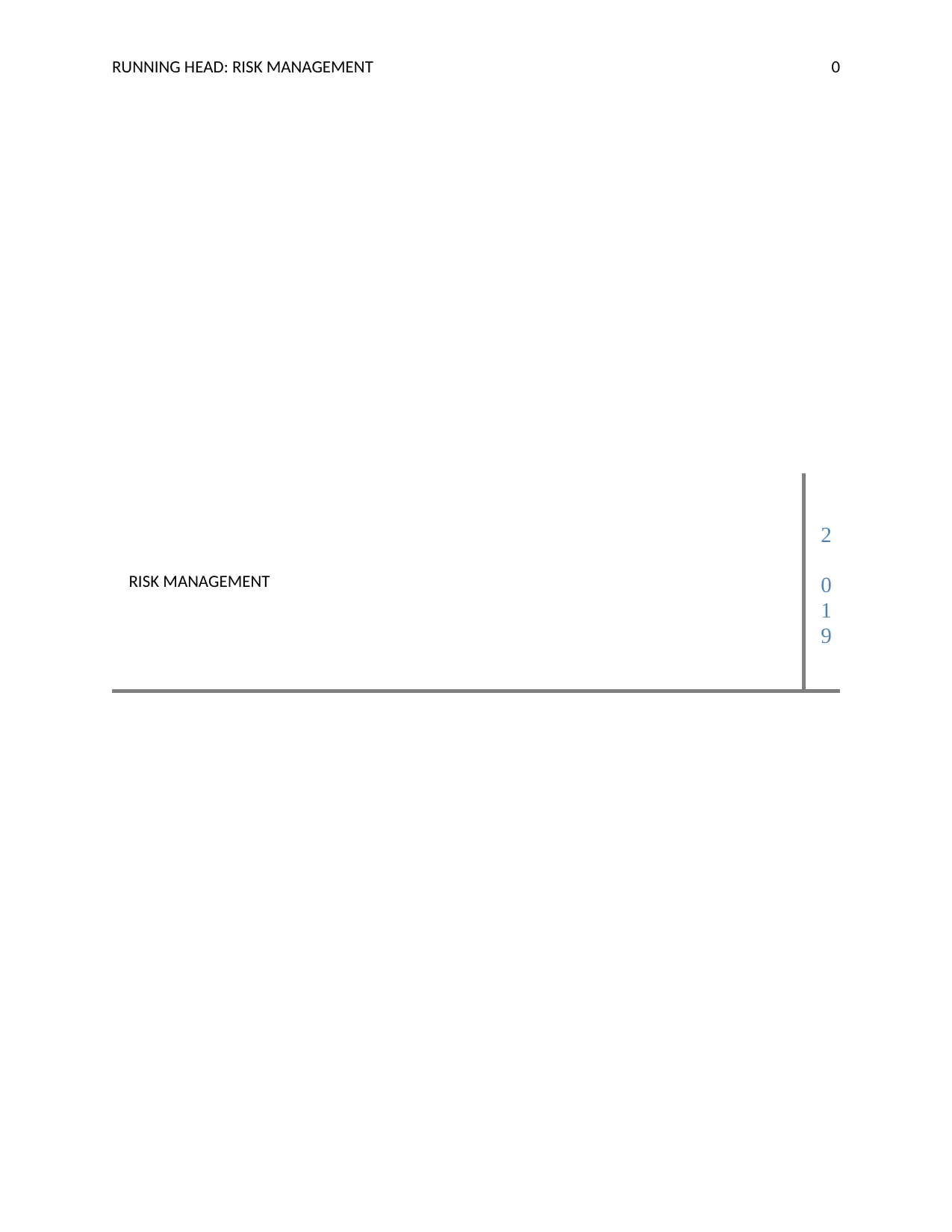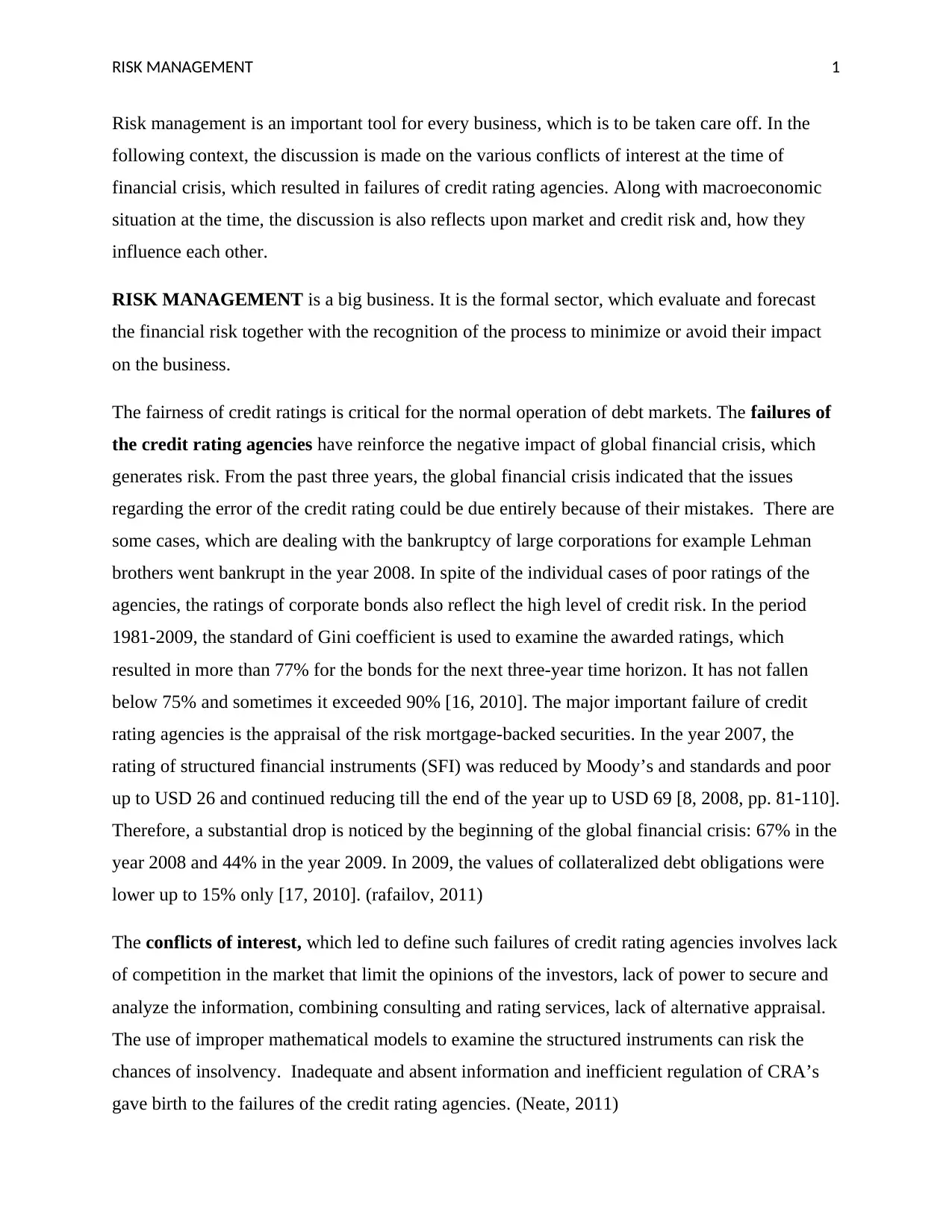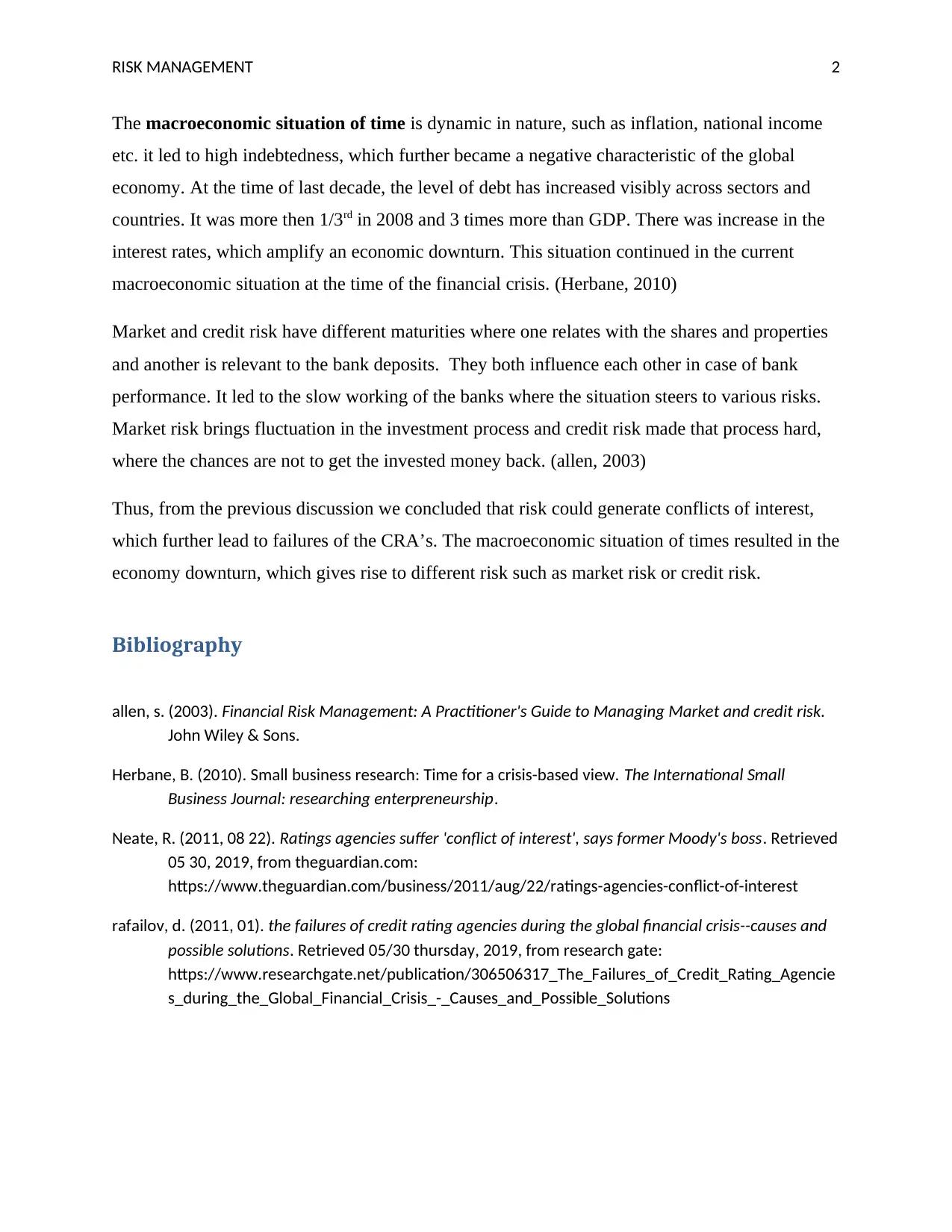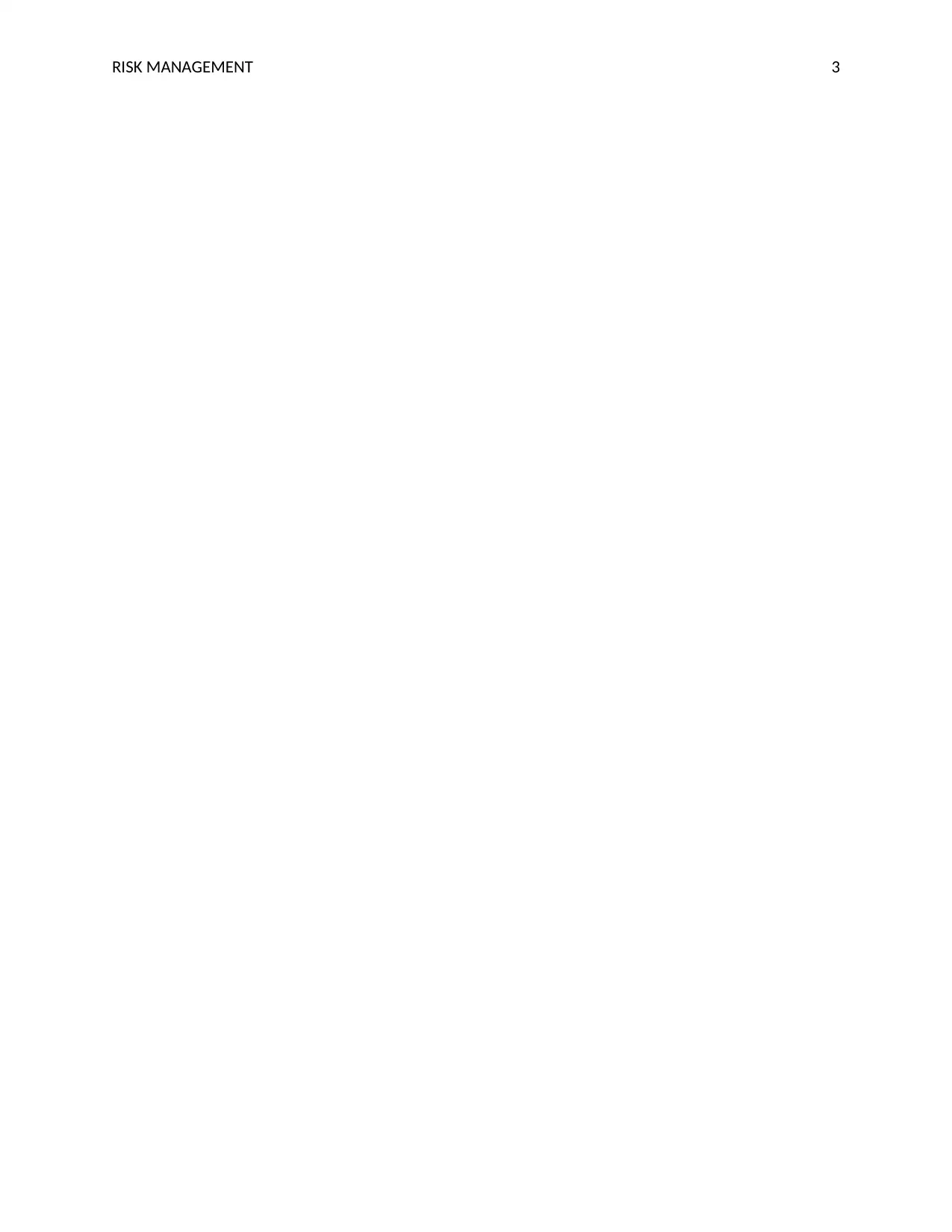Critical Analysis: Failures of Rating Agencies and Risk Management
VerifiedAdded on 2023/03/31
|4
|755
|194
Essay
AI Summary
This essay examines the failures of credit rating agencies leading up to the financial crisis, critically evaluating the conflicts of interest that contributed to these failures. It elaborates on the macroeconomic conditions of the time, including high indebtedness and rising interest rates, and analyzes how market and credit risks influenced each other, particularly in the context of bank performance. The essay concludes that these failures and macroeconomic factors led to economic downturns and various risks, highlighting the importance of effective risk management in preventing such crises.

RUNNING HEAD: RISK MANAGEMENT 0
RISK MANAGEMENT
2
0
1
9
RISK MANAGEMENT
2
0
1
9
Paraphrase This Document
Need a fresh take? Get an instant paraphrase of this document with our AI Paraphraser

RISK MANAGEMENT 1
Risk management is an important tool for every business, which is to be taken care off. In the
following context, the discussion is made on the various conflicts of interest at the time of
financial crisis, which resulted in failures of credit rating agencies. Along with macroeconomic
situation at the time, the discussion is also reflects upon market and credit risk and, how they
influence each other.
RISK MANAGEMENT is a big business. It is the formal sector, which evaluate and forecast
the financial risk together with the recognition of the process to minimize or avoid their impact
on the business.
The fairness of credit ratings is critical for the normal operation of debt markets. The failures of
the credit rating agencies have reinforce the negative impact of global financial crisis, which
generates risk. From the past three years, the global financial crisis indicated that the issues
regarding the error of the credit rating could be due entirely because of their mistakes. There are
some cases, which are dealing with the bankruptcy of large corporations for example Lehman
brothers went bankrupt in the year 2008. In spite of the individual cases of poor ratings of the
agencies, the ratings of corporate bonds also reflect the high level of credit risk. In the period
1981-2009, the standard of Gini coefficient is used to examine the awarded ratings, which
resulted in more than 77% for the bonds for the next three-year time horizon. It has not fallen
below 75% and sometimes it exceeded 90% [16, 2010]. The major important failure of credit
rating agencies is the appraisal of the risk mortgage-backed securities. In the year 2007, the
rating of structured financial instruments (SFI) was reduced by Moody’s and standards and poor
up to USD 26 and continued reducing till the end of the year up to USD 69 [8, 2008, pp. 81-110].
Therefore, a substantial drop is noticed by the beginning of the global financial crisis: 67% in the
year 2008 and 44% in the year 2009. In 2009, the values of collateralized debt obligations were
lower up to 15% only [17, 2010]. (rafailov, 2011)
The conflicts of interest, which led to define such failures of credit rating agencies involves lack
of competition in the market that limit the opinions of the investors, lack of power to secure and
analyze the information, combining consulting and rating services, lack of alternative appraisal.
The use of improper mathematical models to examine the structured instruments can risk the
chances of insolvency. Inadequate and absent information and inefficient regulation of CRA’s
gave birth to the failures of the credit rating agencies. (Neate, 2011)
Risk management is an important tool for every business, which is to be taken care off. In the
following context, the discussion is made on the various conflicts of interest at the time of
financial crisis, which resulted in failures of credit rating agencies. Along with macroeconomic
situation at the time, the discussion is also reflects upon market and credit risk and, how they
influence each other.
RISK MANAGEMENT is a big business. It is the formal sector, which evaluate and forecast
the financial risk together with the recognition of the process to minimize or avoid their impact
on the business.
The fairness of credit ratings is critical for the normal operation of debt markets. The failures of
the credit rating agencies have reinforce the negative impact of global financial crisis, which
generates risk. From the past three years, the global financial crisis indicated that the issues
regarding the error of the credit rating could be due entirely because of their mistakes. There are
some cases, which are dealing with the bankruptcy of large corporations for example Lehman
brothers went bankrupt in the year 2008. In spite of the individual cases of poor ratings of the
agencies, the ratings of corporate bonds also reflect the high level of credit risk. In the period
1981-2009, the standard of Gini coefficient is used to examine the awarded ratings, which
resulted in more than 77% for the bonds for the next three-year time horizon. It has not fallen
below 75% and sometimes it exceeded 90% [16, 2010]. The major important failure of credit
rating agencies is the appraisal of the risk mortgage-backed securities. In the year 2007, the
rating of structured financial instruments (SFI) was reduced by Moody’s and standards and poor
up to USD 26 and continued reducing till the end of the year up to USD 69 [8, 2008, pp. 81-110].
Therefore, a substantial drop is noticed by the beginning of the global financial crisis: 67% in the
year 2008 and 44% in the year 2009. In 2009, the values of collateralized debt obligations were
lower up to 15% only [17, 2010]. (rafailov, 2011)
The conflicts of interest, which led to define such failures of credit rating agencies involves lack
of competition in the market that limit the opinions of the investors, lack of power to secure and
analyze the information, combining consulting and rating services, lack of alternative appraisal.
The use of improper mathematical models to examine the structured instruments can risk the
chances of insolvency. Inadequate and absent information and inefficient regulation of CRA’s
gave birth to the failures of the credit rating agencies. (Neate, 2011)

RISK MANAGEMENT 2
The macroeconomic situation of time is dynamic in nature, such as inflation, national income
etc. it led to high indebtedness, which further became a negative characteristic of the global
economy. At the time of last decade, the level of debt has increased visibly across sectors and
countries. It was more then 1/3rd in 2008 and 3 times more than GDP. There was increase in the
interest rates, which amplify an economic downturn. This situation continued in the current
macroeconomic situation at the time of the financial crisis. (Herbane, 2010)
Market and credit risk have different maturities where one relates with the shares and properties
and another is relevant to the bank deposits. They both influence each other in case of bank
performance. It led to the slow working of the banks where the situation steers to various risks.
Market risk brings fluctuation in the investment process and credit risk made that process hard,
where the chances are not to get the invested money back. (allen, 2003)
Thus, from the previous discussion we concluded that risk could generate conflicts of interest,
which further lead to failures of the CRA’s. The macroeconomic situation of times resulted in the
economy downturn, which gives rise to different risk such as market risk or credit risk.
Bibliography
allen, s. (2003). Financial Risk Management: A Practitioner's Guide to Managing Market and credit risk.
John Wiley & Sons.
Herbane, B. (2010). Small business research: Time for a crisis-based view. The International Small
Business Journal: researching enterpreneurship.
Neate, R. (2011, 08 22). Ratings agencies suffer 'conflict of interest', says former Moody's boss. Retrieved
05 30, 2019, from theguardian.com:
https://www.theguardian.com/business/2011/aug/22/ratings-agencies-conflict-of-interest
rafailov, d. (2011, 01). the failures of credit rating agencies during the global financial crisis--causes and
possible solutions. Retrieved 05/30 thursday, 2019, from research gate:
https://www.researchgate.net/publication/306506317_The_Failures_of_Credit_Rating_Agencie
s_during_the_Global_Financial_Crisis_-_Causes_and_Possible_Solutions
The macroeconomic situation of time is dynamic in nature, such as inflation, national income
etc. it led to high indebtedness, which further became a negative characteristic of the global
economy. At the time of last decade, the level of debt has increased visibly across sectors and
countries. It was more then 1/3rd in 2008 and 3 times more than GDP. There was increase in the
interest rates, which amplify an economic downturn. This situation continued in the current
macroeconomic situation at the time of the financial crisis. (Herbane, 2010)
Market and credit risk have different maturities where one relates with the shares and properties
and another is relevant to the bank deposits. They both influence each other in case of bank
performance. It led to the slow working of the banks where the situation steers to various risks.
Market risk brings fluctuation in the investment process and credit risk made that process hard,
where the chances are not to get the invested money back. (allen, 2003)
Thus, from the previous discussion we concluded that risk could generate conflicts of interest,
which further lead to failures of the CRA’s. The macroeconomic situation of times resulted in the
economy downturn, which gives rise to different risk such as market risk or credit risk.
Bibliography
allen, s. (2003). Financial Risk Management: A Practitioner's Guide to Managing Market and credit risk.
John Wiley & Sons.
Herbane, B. (2010). Small business research: Time for a crisis-based view. The International Small
Business Journal: researching enterpreneurship.
Neate, R. (2011, 08 22). Ratings agencies suffer 'conflict of interest', says former Moody's boss. Retrieved
05 30, 2019, from theguardian.com:
https://www.theguardian.com/business/2011/aug/22/ratings-agencies-conflict-of-interest
rafailov, d. (2011, 01). the failures of credit rating agencies during the global financial crisis--causes and
possible solutions. Retrieved 05/30 thursday, 2019, from research gate:
https://www.researchgate.net/publication/306506317_The_Failures_of_Credit_Rating_Agencie
s_during_the_Global_Financial_Crisis_-_Causes_and_Possible_Solutions
⊘ This is a preview!⊘
Do you want full access?
Subscribe today to unlock all pages.

Trusted by 1+ million students worldwide

RISK MANAGEMENT 3
1 out of 4
Related Documents
Your All-in-One AI-Powered Toolkit for Academic Success.
+13062052269
info@desklib.com
Available 24*7 on WhatsApp / Email
![[object Object]](/_next/static/media/star-bottom.7253800d.svg)
Unlock your academic potential
Copyright © 2020–2025 A2Z Services. All Rights Reserved. Developed and managed by ZUCOL.





